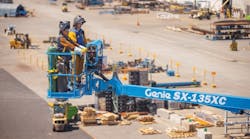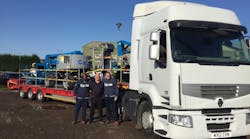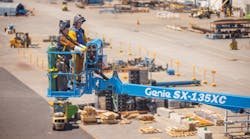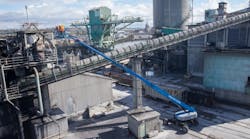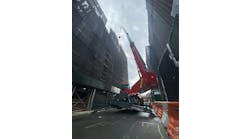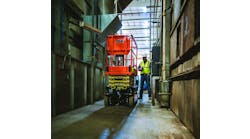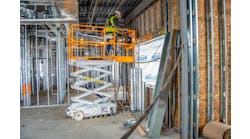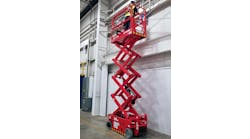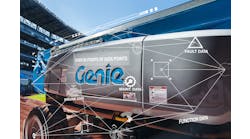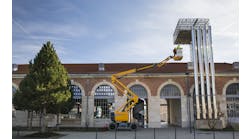As part of a series of interviews with aerial manufacturers, Matt Fearon, president of Genie, Terex AWP, talks about Genie’s development of an electronic secondary guarding solution, maximizing the rental return on invested capital and utilization, innovative fuel electric systems, raising safety awareness and increasing training, enhanced telematics and more.
RER: What have been your most recent technological developments on your equipment?
Fearon: Two important developments Genie has been focused on rolling out are related to the changing requirements of our global customers and how end-users do work safely and productively. The first development is the introduction of the new Genie Lift Guard Contact Alarm system, an electronic secondary guarding solution that we offer standard on most Genie boom products. It is an innovative solution that our customers have been asking for, providing another layer of operator protection at the platform controls. The solution is robust and unobtrusive, but its brilliance is in its simplicity.
From a machine standpoint, Genie is heavily invested in continuing to maximize the value and rental return on invested capital (rROIC) of our products. Even as global standards are changing how operators do work, we are looking at ways of increasing their productivity. The new Genie Xtra Capacity (XC) booms are designed to provide exceptional capacity consistently across a wide range of products. When customers see the “XC” nomenclature on a Genie machine, they will know that they are getting 660-lb capacity over the maximum range of motion, and 1,000-lb maximum capacity to tackle even the heaviest jobs in less time. The “XC” stamp also signifies that these machines meet the overload requirements of the new ANSI and CSA standards for North America, as well as the EN280 standards in Europe and the AS 1418.10 standards in Australia.
What new technological developments are on the horizon for you?
Fearon: As we continue to work with our customers on helping them realize the highest rROIC on their machine purchases, we are finding that maximizing their utilization is key. Providing insights into how a machine is utilized and what may keep it from working are instrumental in planning and operating their businesses. Telematics solutions that include information about how a machine is working, as well as what maintenance may keep it from having to come off a job, are a great way to capture and manage this critical data. We are continuing to work directly with our customers to make sure that they have the access to as much of this information as possible, including a link to our machines via a CAN-based control system, as well as what offerings may make them even more efficient in the future.
In general, what trends do you see coming up in aerial equipment?
Fearon: There are a few trends that we are seeing that are related to some of the development work we have been doing over the last few years. As emissions standards around the world have become more stringent, engine manufactures are forced to provide solutions that are more costly and complex. To mitigate this, Genie has developed an innovative fuel-electric system for the Genie Z-60/37 FE articulated boom that gives performance of a typical diesel-powered boom in a hybrid machine.
Another trend in our industry is the focus on secondary guarding for the operator. We have developed multiple solutions that have been well received by our customers and end-users. The Genie Operator Protective Structure (OPS) is a “mechanical” secondary guarding solution that creates a protective zone around the operator at the boom controls, while this option is incredibly effective it can sometimes interfere with the work that is being done. The new Genie Lift Guard Contact Alarm system is our “electronic” secondary guarding solution. It is a simple and effective solution that provides an added layer to operator protection by immediately cutting boom functions and alerting with lights and horn once activated. Unlike many other solutions available in the market, the Genie Lift Guard Contact Alarm system was designed to provide a “free movement zone” around the operator where, even if the operator has triggered the system by being forced into the trip sensor, they have space to move and recover themselves out of harm’s way.
How will the next version of the ANSI standards change things in the aerial equipment market? What changes are you making in manufacturing to conform to those incoming standards?
Fearon: The three biggest changes for the North American aerial market with the new standards coming on line will be the inclusion of “load weighing” or “load sense” systems, the requirements to consider wind forces on machines and the function restriction at chassis tilt limits. These concepts, while familiar globally in areas like Europe, Asia and Australia, will in many cases change how our end-users will need to plan and complete their work. When looking at many of the applications our products are used in, things like platform capacity, indoor versus outdoor operation or the terrain of a jobsite can easily be glossed over when planning work. With the requirements to begin limiting functionality based on the machines specifications, we are aiming at mitigating much of these impacts by making machines even more capable in these otherwise restrictive conditions.
What new safety developments and safeguards have you made on your equipment?
Fearon: The new Genie Lift Guard Contact Alarm system is a great response to the industries demand for simple, effective and unobtrusive solutions to operator protection. It is now standard on most Genie boom models available. Introduced in early 2017, it has been extremely well received by our customers and end-users globally.
Any new developments in training?
Fearon: From a training and safety perspective, one of the biggest challenges the industry sees right now is increasing awareness about why safety training is so important. Many companies don't understand their responsibilities, under ANSI/CSA standards, which includes training requirements for aerials — and, not just that they're required by law and enforced by OSHA, but there are very good reasons for the training to keep their operators’ safe. When companies don't invest the time or money to train their people, they chose to take a chance and hope nothing happens. Ensuring that operators, and personnel, are properly trained is one of the first steps in helping to prevent accidents.
To counteract this trend, Genie has made it a company mission to not only raise awareness for training, but we are also committed to helping train the industry. We continue to offer Train the Trainer and our Genie Lift Pro™ Online Training Courses, a high-quality, professional-grade program delivered through a web-based platform. The Genie Lift Pro Online Operator Training Courses satisfy the general training requirements as defined by OSHA, ANSI, ITSDF and CSA.
In general, what are your expectations for the aerial market in the foreseeable future, in North America and internationally?
Fearon: As our customers continue to become more technological savvy, we are seeing growing trend in the use of technology for fleet management. Telematics is a tool that many are starting to use to manage their equipment fleets, from basic location tracking to more sophisticated equipment monitoring. From knowing how equipment is performing or how often a piece is being utilized to where each unit is or when it is ready for maintenance, machine data can provide a lot of insight to a rental business. Today’s technology can help our customers gather, read and understand the information their machines are providing. In my opinion, we are in the early stages of the adoption of telematics, mobile applications and data-driven fleet management. I expect rental companies around the world to increase their use of these capabilities in the coming years to drive higher rROIC.
